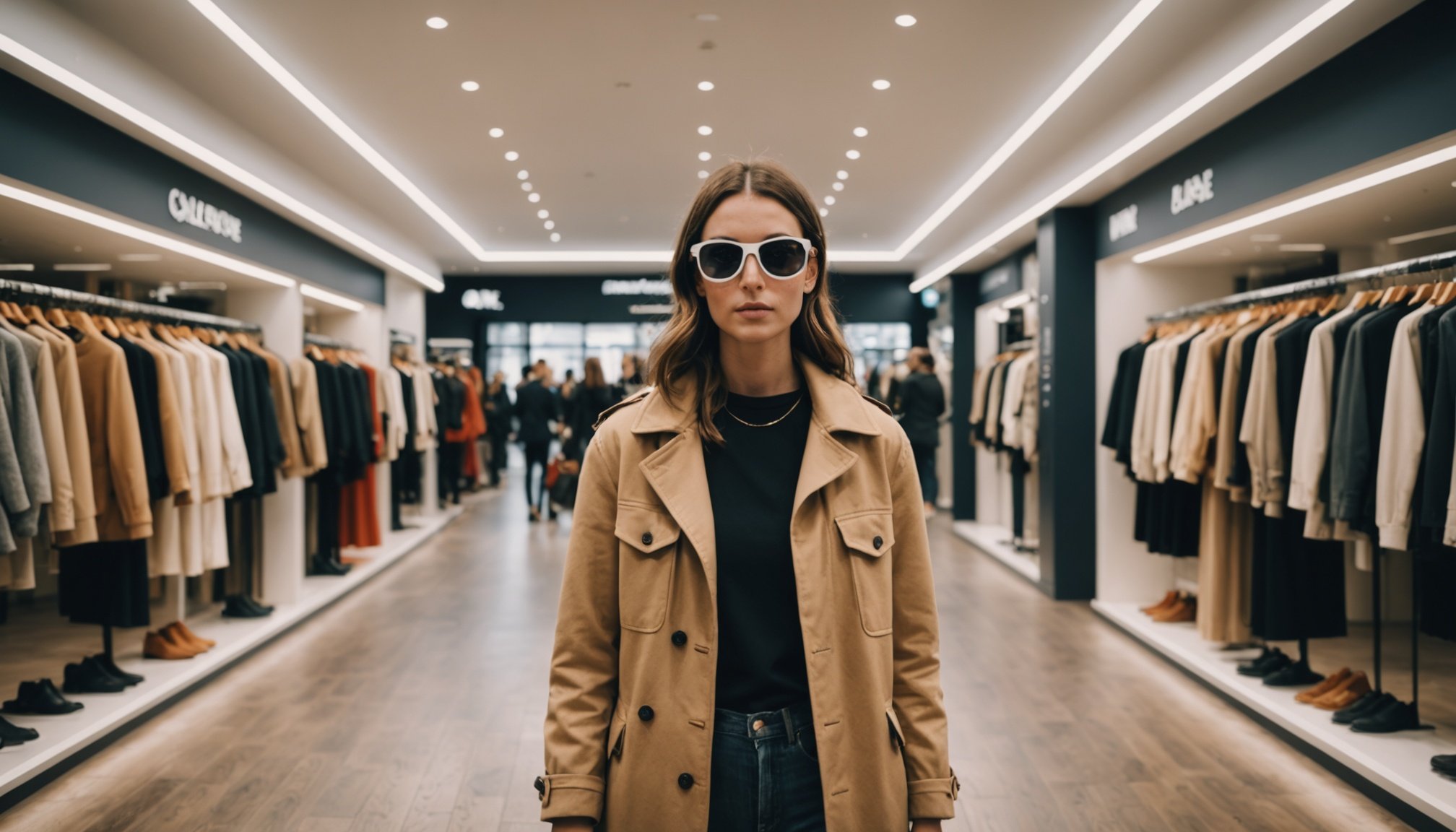The Impact of Augmented Reality on Fashion Retail
Augmented Reality (AR) is revolutionising the fashion retail sector by bridging the gap between online and in-store shopping experiences. Within fashion, AR technology includes innovative tools that allow customers to virtually try on clothes and accessories, thereby significantly enhancing user engagement and satisfaction. This transformation is changing how consumers interact with fashion brands, making the shopping process more dynamic.
In the UK fashion industry, there is a noticeable surge in the adoption of AR technologies. Leading brands are experiencing a transformation in how they approach consumer interaction and promotion strategies. This trend in AR usage is primarily driven by the industry’s need to adapt to digital consumption patterns and offer seamless shopping solutions.
In parallel : Mastering Data for UK Logistics: Your Ultimate Guide to Revolutionizing Supply Chain Management
The key benefits of AR for both consumers and retailers are manifold. Consumers enjoy interactive, personalised shopping experiences that lower the uncertainty involved in online purchases. For retailers, AR technology offers improved customer engagement, potentially leading to increased sales and customer loyalty. The ability to provide a realistic product visualisation without physical inventory also helps retailers optimise their resources and cater to a global audience. Thus, AR is not only enhancing the shopping experience but also redefining fashion retail strategies.
Case Studies of Innovative Brands Utilizing AR
Augmented Reality (AR) is transforming the portfolio of strategies leveraged by fashion brands worldwide. Through these innovations, retailers are opening new realms of customer interaction and engagement.
Also to see : Unlocking Data Security: Your Ultimate Guide to Protection for UK Tech Startups
Leading Brands Embracing AR Technology
Consider the likes of Burberry and Zara, who have successfully implemented AR technology, setting new benchmarks in retail. These brands have pioneered dynamic AR experiences, creating a buzz around AR innovations within the fashion industry. Their initiatives spotlight how AR can simultaneously captivate and inform, making the virtual world an essential part of their retail strategy.
Notable AR Initiatives and Campaigns
A plethora of campaigns exhibit the creative utilisation of AR. For instance, Gucci’s AR shoe try-on feature through Snapchat was revolutionary, allowing users to virtually “wear” its latest sneaker collections. Similarly, Adidas launched an AR app to bring virtual stores to life, enhancing customer engagement and increasing accessibility to their products.
Success Metrics and Customer Feedback
Success isn’t just in the adoption but measurable outcomes. These campaigns reported significant increases in user engagement, with tailored feedback illuminating improvements in consumer satisfaction and shopping convenience. Analytics have shown boosts in online sales conversion rates and customer loyalty, underscoring the value AR brings to progressive fashion retail.
Benefits of Augmented Reality for Retailers
As augmented reality technology continues to influence the retail domain, its advantages for retailers are profound. One notable benefit is the improvement in inventory management. By engaging AR technology, retailers can showcase realistic product visualisation without holding physical stock. This enables a more efficient use of inventory space and resources, optimising both cost and customer experience.
Another compelling benefit is in enhancing customer loyalty and retention. Providing unique and interactive experiences keeps customers engaged, turning casual shoppers into dedicated patrons. AR’s ability to create personalised and memorable shopping journeys strengthens the bond between brands and consumers.
Importantly, retailers are witnessing an improvement in sales conversion rates. With AR, hesitant shoppers become more confident in their purchasing decisions due to better engagement and product understanding. Statistical analyses demonstrate a clear correlation between AR use and increased sales performance, highlighting its pivotal role in modern retail strategies.
The strategic use of augmented reality is not just about staying competitive; it’s about reshaping the entire fashion retail landscape. These benefits collectively contribute to creating a sustainable business model for retailers, primed for enduring success in an ever-evolving market.
Benefits of Augmented Reality for Consumers
Augmented Reality (AR) is reshaping how consumers engage with fashion retail, offering a plethora of benefits that enhance the shopping experience. One of the primary advantages is the introduction of virtual try-on options, enabling shoppers to visualise clothing and accessories on themselves without physical interaction. This innovative approach not only personalises the shopping journey but also reduces the hesitation linked with online purchases.
AR technology significantly boosts convenience and engagement by turning shopping into a truly interactive experience. Shoppers can effortlessly explore styles and make informed choices, engaging with their favourite brands in a dynamic, immersive manner.
The impact of AR on purchasing decisions is profound. Consumers are more confident when they can visualise products realistically, translating into higher satisfaction and reduced return rates. This enhanced confidence stems from the ability to thoroughly evaluate a product prior to purchase, leading to a more committed and certain decision-making process.
In summary, AR is transforming the retail landscape by offering consumers enhanced shopping experiences that are not only tailored to their preferences but also more engaging and informative, ultimately fostering a stronger buyer confidence through realistic visualization and interaction.
Future Trends in Augmented Reality for Fashion Retail
Expect the future of AR in fashion retail to be both exciting and transformative. Industry experts foresee AR technology evolving significantly, where its integration into retail spaces could become as commonplace as e-commerce is today. The expected developments include enhanced realism in virtual try-ons, making online and in-store shopping experiences almost indistinguishable.
The marriage of AI and machine learning with AR is another promising avenue. This union can offer predictive styling advice, allowing brands to suggest outfits based on weather forecasts or social events on your calendar, enhancing personalisation like never before.
One of the most intriguing predictions is AR’s progression towards persistent augmented environments, enabling users to interact with virtual fashion items in their real-world settings over multiple sessions. This consistent experience can drive deeper brand engagement and loyalty.
Experts from within the fashion tech sphere also highlight upcoming challenges, such as maintaining the authenticity of virtual fashion and safeguarding consumer data. Nevertheless, the opportunities are vast. The shift of AR from mere novelty to a must-have feature can significantly reshape how brands offer their merchandise, engaging consumers in ways traditional retail never could. Fashion retail stands on the brink of a pioneering digital transformation, poised for growth and innovation.
Statistics on AR Adoption in the UK Fashion Industry
Augmented Reality (AR) is progressively integrating into the UK fashion sector, with adoption rates signifying robust growth. Current adoption rates among retailers are experiencing an upward trend, particularly as businesses seek competitive advantages in a digital landscape. Reports suggest that numerous fashion brands have implemented AR to stay relevant and meet evolving consumer expectations.
Consumer awareness and interest in AR features have seen a substantial increase, driven by the captivating and interactive experiences that AR provides. Shoppers are becoming more familiar with these technological innovations, reflecting a growing demand for immersive shopping solutions that bridge the gap between online and physical stores.
By conducting a comparative analysis with other retail sectors, it becomes evident that the fashion industry is at the forefront of AR adoption. The interactive nature of fashion purchasing naturally lends itself to visual and engaging AR applications, making it a pioneering domain in this technological advancement. Retailers in other sectors may follow suit as they seek to replicate the enhanced consumer engagement achieved by fashion brands through AR.
The consolidation of these statistics illustrates the steadfast integration of AR in fashion, suggesting transformative shifts in how fashion retail operations are conducted in the UK market.
Expert Opinions on Next-Generation Virtual Shopping Experiences
In the evolving realm of virtual shopping, fashion industry leaders offer insights into emerging technologies shaping the future. Integrating Augmented Reality in Fashion with other innovations, such as AI, is pivotal for crafting seamless experiences. These technologies collaboratively enable smarter, tailored interactions through predictive analytics, enhancing customer satisfaction.
Industry authority figures stress the importance of AR in virtual environments, transforming consumer interactions with brands. AR facilitates a blend of physical and digital experiences, crucial in building lasting retail engagement. Leaders foresee a shift where AR becomes ubiquitously integrated into shopping habits, rather than a mere supplementary feature.
However, industry experts highlight challenges such as developing universal AR standards and enhancing data privacy. As next-generation solutions evolve, brands must navigate these complexities to harness the full potential of AR.
Opportunities abound: the emergence of persistent augmented environments could foster ongoing personalisation, while collaborations with tech giants might drive innovation in fashion retail. With these advancements, the future of virtual shopping appears promising, offering enhanced customisation and enriched brand-consumer dynamics. The emphasis remains on proactive adaptation and strategic implementation, ensuring AR’s role as a cornerstone in advancing shopping experiences.











